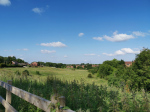Widening where we live
Sonder (noun): The profound feeling of realizing that everyone, including strangers passed in the street, has a life as complex as one’s own, which they are constantly living despite one’s personal lack of awareness of it.
Coined in 2012 by John Koenig, whose project, ‘The Dictionary of Obscure Sorrows’, aims to come up with new words for emotions that currently lack words.
Last week, whilst driving through the local area, my Mum and I invented a game. We had been running an errand, and as the bridge to darkness known as 4pm descended, we were on our way back, and my Mum asked if anyone I knew had put up Christmas decorations yet. Circa mid-November, I replied that no, they hadn’t, to which she responded by asking if I’d seen any in the houses we’d been driving past. This is what led to the game – ‘see how many festively decorated houses you can count on one drive!’ Cue me excitedly rubbernecking front windows from the passenger seat, scanning for trees, lights and wreathes with the unabashed curiosity of a 3 year-old, as the sky slowly deliberates between grey, orange and navy blue. Overall, I counted ten Christmas trees.

Sneaking glances into peoples’ windows during that chink of time when lights are switched on but curtains aren’t closed is something I’ve always loved. Nosy? Yes. Transgressive? Perhaps – but peering into the world outside of your own head, thinking about every person in every room of every house or flat, switching on every little light, makes the place we live in feel so much bigger. At the moment, when many may be feeling a sense of frustration with this very stationary year, switching our focus to the unknown lives of those around us can make where we live boundless. This claustrophobic time can be combatted with the mere knowledge that we will never know every hallway, kitchen, bathroom or attic in Saddleworth. And it’s refreshing, to know that there’s this forever undiscovered richness of life.
Saddleworth cannot be described as urban, but there is still a dense population here (approximately 25,500 according to a 2019 census). For me, this is enough to make flâneuring possible. The flâneur, a word first taken from French, is a male figure with privilege and time enough for leisure, who wanders around the city as a form of both observation and assimilation. His ambling is aimless, but allows time for escape and reflection – an isolated stroll yet with an outward focus on city life. Blissful. Since the time when only men could take this liberty, and pen their thoughts on it, the word has, rightly, evolved – the female figure of the flâneuse, the escapist transgressive who walks the streets, has been able to emerge. That such an introspective and freeing pastime must be so gendered is sad to me, but this aside, I feel that flâneusing or flâneuring the streets of Saddleworth is a true escape and not necessarily so different to the traditional escape of fleeing up a hill or into the woods. On the whole, we seem to find ourselves singing the praises of nature, so it can be an odd realisation to come to that walking deliberately through areas of housing, or along main roads, can be something really enjoyable. Often, I glimpse birthday cards lined up on windowsills, photo-frames, main lights hanging omnisciently in front rooms, and I think how familiar these things must be to whoever owns them, how very normal. Everyone we see has a huge and constant life, just like ours, and thinking individually about them can be a great escape from our own repetitive world.

The more of us there are, the more potential this place has got. When I was thinking about writing this piece, I thought about just how many people have lived in Saddleworth, and how that history surrounds us, whether we have ancestors here or not. This led to my scouring of the British Newspaper Archive online, to find old local articles and this time peer not into peoples’ actual windows, but into the window of the past. Most of the articles I found were Victorian-era, taken from the ‘Huddersfield Chronicle’.

The article I most enjoyed, published Saturday 6th June 1863, detailed the different celebrations by Saddleworth schools of Whit-Friday. Each school appears to have gathered in the morning, taken a long walk, along the way depositing themselves at various churches, wealthy residences, and large public spaces, sung at each of these stops, and then returned in the evening for some form of refreshment. The article holds unwarranted, sometimes exhaustive detail; how many girls and boys in each school, how many teachers, exactly what was eaten… the children of Uppermill Wesleyan School had “currant bread and treacle beer” at about 9am, and Delph Wesleyan School had 322 books in its library. One feature was strikingly close to home and that was the report that “Whit-Friday of the present year was very unfavourable on account of the rain”. Inhabitants of Saddleworth all know what that feels like. In seriousness, however, the level of description was actually companionable. It was so gloriously mundane that, as I read it, I felt swallowed by these real, standard lives, these recounts of people who knew the same places as we know today. Picturing so vividly the ordinary lives of inhabitants all those years ago gave me the same anonymising feeling as flâneusing today’s streets. A place can be as large as you dream it.

Just like the Christmas trees slowly springing up as this season unfolds, every person’s life is intricate and ornamented. Now, more than ever, it is easy to sink into our own heads, but remembering these individual lives of strangers, whether factual and recorded (like in the BNA) or invisible and imagined (on the streets we traverse), can unveil a portal into a much bigger headspace. I’m one of those lives; I’m sitting here now, with my curtains open and my lamp on, quietly inviting people to look into my own pool of cosiness.
I dare you to sneak a quick glance – I’ll probably never know.





[…] and a bizarre amount of Christmas lights still floating overhead (not that I’m complaining, I love them!). The different eras of architecture jump out and form a sort of patchwork quilt for the eyes. In […]